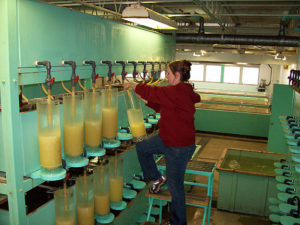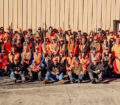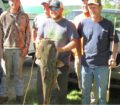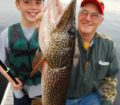By Steve Weisman
 When you catch a walleye in Iowa, there’s a good chance that the fish got its start in one of Iowa’s walleye hatcheries. Since walleye often don’t reproduce naturally in the state’s inland rivers and lakes, their populations must be maintained through the Iowa DNR’s stocking program. The hundreds of millions of eggs needed annually to keep populations healthy are predominately collected from wild broodstock populations in Big Spirit Lake, East and West Okoboji Lake, Storm Lake and Clear Lake.
When you catch a walleye in Iowa, there’s a good chance that the fish got its start in one of Iowa’s walleye hatcheries. Since walleye often don’t reproduce naturally in the state’s inland rivers and lakes, their populations must be maintained through the Iowa DNR’s stocking program. The hundreds of millions of eggs needed annually to keep populations healthy are predominately collected from wild broodstock populations in Big Spirit Lake, East and West Okoboji Lake, Storm Lake and Clear Lake.
Earlier this year, I visited with the DNR biologists Mike Hawkins and Jonathan Meerbeek at the Spirit Lake Hatchery about potential changes coming for the walleye slot limit regulations on the Iowa Great Lakes, Storm Lake and Clear Lake for 2022. This past week, the Iowa DNR announced that the slot limit regulation changes will go into effect on January 1, 2022. Here is what this means for these three broodstock areas.
For the Iowa Great Lakes (Big Spirit Lake, East and West Okoboji Lakes, Upper Gar Lake, Minnewashta Lake, Lower Gar Lake) and Storm Lake, the protected slot size limit will now be 19 inches to 25 inches. The daily bag limit will be three walleyes with one walleye over 25 inches. Until the end of December, the current 17 inch to 22 slot size limit will continue.
Clear Lake, meanwhile, will go from its current 14-inch minimum length limit to a protected slot size limit of 17 inches to 22 inches. The daily bag limit will be three walleyes with one over 22 inches.
Reasons for the change
The original slot size regulation on the Iowa Great Lakes and Storm Lake was instituted in January of 2007. Prior to that, a minimum length limit (14 inches on the Iowa Great Lakes and 15 inches on Storm Lake) had been in place for 20 years. Over that time, biologists documented several periods when walleye would “stockpile” just below the length limit. In some years, anglers would have to sort through dozens of small fish to finally catch one 14-inch walleye at the Iowa Great Lakes and a 15-inch walleye on Storm Lake. Analysis and modeling showed that a protected slot limit was a better regulation and could prevent this log jam of walleyes. Analyses also showed that a protected slot would increase the number of broodstock females.
At Clear Lake, modeling also shows that a protected slot will have positive impacts like those seen on the other lakes where protected slot limits have been implemented.
The changes to the walleye regulations on these lakes are tailored to each population, and the DNR will continue to assess these regulations in the future and recommend changes as needed.
2007 to 2021
In January of 2007, after weighing angler input and all of that data, the decision was made on the Iowa Great Lakes and Storm Lake to change to the current 17” to 22” protected slot with harvest allowed on one walleye over 22”. Reflecting on the past 14 years, the slot has had a positive impact on these broodstock lakes. Overall size and growth rates have improved, stockpiling of small fish is less likely and the walleyes are generally in excellent condition.
However, over the last couple of years, the data has shown that the protected slot wasn’t perfect, and with a slight tweak could improve the entire fishery. Male walleyes grow much slower than females after they reach five years old, which according to Hawkins and Meerbeek is common for most species of fish. Egg producing females usually grow much bigger. As a matter of fact, many of the male walleyes will never grow out of the protected slot causing a disproportionate number of males that can’t be harvested.
According to Meerbeek, “Modeling indicates that this slot length change will allow anglers a bit more time to harvest male walleyes and help prevent stockpiling of male fish in the protected slot. A few females will also be harvested, but because females grow faster, they will be susceptible for a shorter period. In fact, the model predicts female broodstock numbers will actually increase slightly after the regulation changes.”
Meanwhile, Fisheries Biologist for Clear Lake, Scott Grummer, also sees the potential for improving broodstock populations there. Although Clear Lake stuck with a minimum size limit after the 2007 change on the Iowa Great Lakes and Storm Lake, Grummer is confident a new slot limit will also benefit Clear Lake’s population. The DNR will start with the 17-to-22-inch protected slot size limit there and closely monitor its effects.
Hawkins adds, “Walleye populations in these broodstock lakes are extremely important to Iowa’s walleye program. The slot limit implemented in 2007 was very successful at balancing our goals of improving the adult population of large females while still allowing for some good angler harvest. This small adjustment should be even more popular with anglers, allowing a bit more harvest, while still accomplishing our goal of a healthy broodstock population.”















